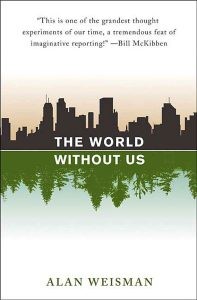The World without Us
Review: The World without Us
by The one-handed economist
one-handed-economist.com
I just read this 2007 book by Alan Weisman, and it’s encouraging — not because it gives me any hope for humans but for the Earth.
Weisman goes on a tour of human impact (and destruction), looking at one problem (plastics, pollution, biodiversity, etc.) or place (the oceans or cities) at a time. The book is packed with facts and useful context. Here are a few notes (not quotes!) of interest:
- Plastic will take millions of years to disappear, via plate tectonic sublimation. GHGs, OTOH, will be “back to normal” in 100,000 years. Oceanic life, even if all the corals die in the short run, will come back strongly after only a 1,000 years. The same is true for avian life.
- Evolutionary pressures will reverse nearly every intervention we’ve made to “improve” animals and plants. Some of the invasives we’ve introduced (e.g., rats) will persist, but they will be disadvantaged without our constant protection of their (our) habitats.
- If the clathrates melt, then we’re going to a climate of 250 million years ago, which will dramatically challenge anything now alive.
- The species we claim to be protecting (“save the whales”) are only in trouble because of us. The best thing we can do for them is to voluntarily extinct our own species. That would really be “giving back” but — ironically — it’s unlikely as long as humans think that the Nature is only there for our entertainment or subsistence.
- It’s kinda sad that the entire funeral industry promises some sort of “eternal memory” but delivers environmental pollution.
- Weisman more or less proposes the same “one child per woman” policy (or goal) that I had around 15 years ago , i.e., to either give every baby boy and girl a permit for 0.5 kids (cap and trade) or to sterilize half the population, so that kids grow up as either “breeders” or “players.”
I don’t think that we will ever make space for other species, so the ideas in this book will probably only manifest as we collapse ecosystems and force humanity into a future that could vary from interesting to savage. Nature will be fine.* I give this book FIVE STARS.
*”You know what makes me happy? Watching my species destroy itself. I take it as a sport, as a kinda hobby, and I root for the complete destruction of this culture that we live in. I root for the underdogs. I root for Nature because on this planet at this time, Nature is the underdog.” — George Carlin


At last I have read an article that inspires no further cynicism in me because it is entirely cynical enough on its own. The absolute worst thing about cynicism is almost always being correct. There was a time where the worst thing about cynicism was always being nearly alone, but that time has passed.
“No matter how cynical you get, it is impossible to keep up.”
~Lily Tomlin